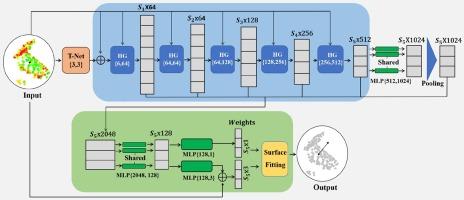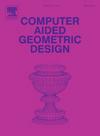GeoHi-GNN:用于正态估计的几何感知分层图表示学习
IF 1.7
4区 计算机科学
Q3 COMPUTER SCIENCE, SOFTWARE ENGINEERING
引用次数: 0
摘要
法线估算一直是点云分析的关键任务之一,而面对严重的噪声或复杂区域时,法线估算就显得非常具有挑战性。挑战主要来自于估算支撑点的选择,即点的选择和点的尺度选择不当会导致信息不足、细节丢失等问题。为此,本文提出了一种以特征为中心的拟合方案--GeoHi-GNN,通过学习几何感知的层次图表示来进行拟合权重估计。主要功能模块是持续进行的分层几何感知(HG)模块,包括两个核心操作,即图节点构建(GNC)和几何感知动态图卷积(GDGC)。图节点构建(GNC)旨在将特征信息聚合到较少的节点上,提供全局到局部的信息,同时避免较大尺度的噪声干扰。由于这些节点分布在不同尺度上,GDGC 可根据内在特征和外在几何信息动态更新节点特征。最后,通过级联分层图形特征来估算曲面拟合中支持点的权重。通过广泛的实验和与同行的综合比较,我们的方案展现出了许多诱人的优势,如几何感知和鲁棒性,从而为更精确的曲面重建等进一步的应用提供了能力。本文章由计算机程序翻译,如有差异,请以英文原文为准。

GeoHi-GNN: Geometry-aware hierarchical graph representation learning for normal estimation
Normal estimation has been one of the key tasks in point cloud analysis, while it is challenging when facing with severe noises or complex regions. The challenges mainly come from the selection of supporting points for estimation, that is, improper selections of points and points' scale will lead to insufficient information, loss of details, etc. To this end, this paper proposes one feature-centric fitting scheme, GeoHi-GNN, by learning geometry-aware hierarchical graph representation for fitting weights estimation. The main functional module is the continuously conducted Hierarchically Geometric-aware (HG) module, consisting of two core operations, namely, the graph node construction (GNC) and the geometric-aware dynamic graph convolution (GDGC). GNC aims to aggregate the feature information onto a smaller number of nodes, providing global-to-local information while avoiding the interferences from noises in larger scales. With these nodes distributed in different scales, GDGC dynamically updates the node features regarding to both intrinsic feature and extrinsic geometric information. Finally, the hierarchical graphical features are cascaded to estimate the weights for supporting points in the surface fitting. Through the extensive experiments and comprehensive comparisons with the state-of-the-arts, our scheme has exhibited many attractive advantages such as being geometry-aware and robust, empowering further applications like more accurate surface reconstruction.
求助全文
通过发布文献求助,成功后即可免费获取论文全文。
去求助
来源期刊

Computer Aided Geometric Design
工程技术-计算机:软件工程
CiteScore
3.50
自引率
13.30%
发文量
57
审稿时长
60 days
期刊介绍:
The journal Computer Aided Geometric Design is for researchers, scholars, and software developers dealing with mathematical and computational methods for the description of geometric objects as they arise in areas ranging from CAD/CAM to robotics and scientific visualization. The journal publishes original research papers, survey papers and with quick editorial decisions short communications of at most 3 pages. The primary objects of interest are curves, surfaces, and volumes such as splines (NURBS), meshes, subdivision surfaces as well as algorithms to generate, analyze, and manipulate them. This journal will report on new developments in CAGD and its applications, including but not restricted to the following:
-Mathematical and Geometric Foundations-
Curve, Surface, and Volume generation-
CAGD applications in Numerical Analysis, Computational Geometry, Computer Graphics, or Computer Vision-
Industrial, medical, and scientific applications.
The aim is to collect and disseminate information on computer aided design in one journal. To provide the user community with methods and algorithms for representing curves and surfaces. To illustrate computer aided geometric design by means of interesting applications. To combine curve and surface methods with computer graphics. To explain scientific phenomena by means of computer graphics. To concentrate on the interaction between theory and application. To expose unsolved problems of the practice. To develop new methods in computer aided geometry.
 求助内容:
求助内容: 应助结果提醒方式:
应助结果提醒方式:


